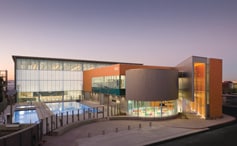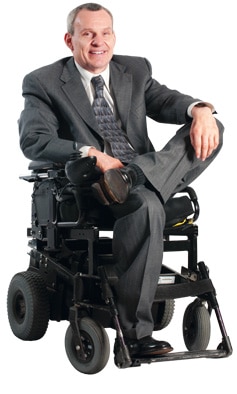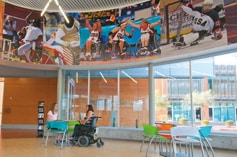

The grand opening of the Virginia G. Piper Sports & Fitness Center for Persons with Disabilities was Feb. 24, although SpoFit — as it’s fondly called by staff and members — has been open since October of last year. SpoFit is built and run on a grand scale. It boasts a pool that’s deep enough on one end for scuba diving, a synthetic climbing wall, two adjoining hardwood playing courts and an incredible 7,500-square-foot fitness room. There’s even a track suspended above the basketball courts. And yet, SpoFit feels like a local community gym, down-to-earth enough for an average wheeler to drop in and enjoy a soothing yoga session or a heart-pounding Zumba class, or just get some workout pointers from a personal trainer.
“Basically people with disabilities want to be included in the day-to-day of society and don’t like to be looked at as different,” says Gabe Gerbic, SpoFit’s fitness coordinator and a T12-L1 para. “Unfortunately in fitness there hasn’t been a lot of inclusion for disability, so we’re trying to change that.”
Located in Phoenix, Ariz., SpoFit offers membership to people with disabilities and their families, and there are different pricing options based on frequency of use. For more information, call 602/386-4566 or go to disabilitysportscenter.com.

Photo by Loren Worthington
Phil Pangrazio: Right Man,Right Time
Phil Pangrazio, president and CEO of Arizona Bridge to Independent Living, has every right to be proud of the nonprofit’s new Sports and Fitness Center. Known as SpoFit, the center is an architectural masterpiece of advanced accessibility that invites wheelchair users and their family members to get involved in the sport or fitness activity that best fits their abilities. The multimillion dollar facility puts major chain fitness centers to shame. Built with help from Phoenix-area voters, it serves as a model for other major cities to emulate — if they can.
A Community is Born
Pangrazio’s vision propelled SpoFit to quickly become a community center for disability sports throughout the West, with athletes coming from as far north as Washington state to participate in tournaments, such as the martial arts one that took place in April, or Wounded Warrior activities, like the USMC camp in November.
Regional basketball and rugby tournaments are becoming common, and Paralympic coaches are scouting SpoFit as a place to groom future gold medalists. But it’s not just about elite athleticism. The typical gym mainstays of tai chi and Zumba classes are offered, as well as the chance to work out with a personal trainer on shiny new Cybex and SCIFIT machines, regardless of your ability level.
“So often during my 32 years of living with a disability,” Pangrazio noted when introducing SpoFit, “I’ve heard somebody say, ‘I can’t exercise because I am disabled.’ Or, ‘The facility and equipment is not accessible and the instructors just don’t understand my needs.’ Well, that can no longer be your excuse. All of those problems have been remedied at SpoFit. The facility is extraordinarily accessible, and the staff is very knowledgeable and expert in understanding your unique needs.”
“It’s pretty amazing, and extremely beautiful aesthetically,” agrees Amber Blanchard, SpoFit’s manager. Blanchard’s no newbie. After earning a degree in therapeutic recreation in 1999, she served as the therapeutic recreation program coordinator at the Bend Park and Recreation District in Bend, Ore., and as program director of Oregon Adaptive Sports. “The spirit here at SpoFit is truly amazing,” she says. “We are creating opportunities for people to be engaged in competitive sports, and also to get the skills and confidence they need to go out in the community. Our goal is community integration, and we’re a program of ABIL — we are a bridge to independent living, not the stopping point.”

Blanchard notes there is often a gap between doing well in a rehab setting and making it out in the community. “Most everyone says the biggest barrier when they’re released is navigating their home. And when they decide they want to get active again they may not know how to do it or where to start. So we introduce them right out of rehab so they have the materials, or at least know who to call.”
It’s Pangrazio’s personal experience of benefiting from this type of sports-based bridge from rehab to real life that inspired him to shepherd SpoFit into existence.
At the age of 19 in 1979, Pangrazio sustained a C6-7 spinal cord injury in a car accident. For the next 10 years, he says, “I was just trying to figure out what to do with my life.” All he knew for certain was he would have to find a way to become independent.
His goal led him to Arizona State University in Tempe, Ariz., on the outskirts of Phoenix, a campus and college town where level terrain and sunny weather attract many students who use wheelchairs. Pangrazio graduated with a bachelor’s in health services administration in 1985. The next five years were a time of learning by trial and error. He took a number of internships — in the office of a state senator, at St. Joseph’s Hospital and at Good Samaritan Hospital. Meanwhile he earned a master’s degree in 1990 and was hired by a county hospital, the Maricopa Medical Center.

Like many people who enter the world of SCI at a young age, Pangrazio’s main focus in his 20s was finding his niche in a culture that suddenly seemed distant and unwelcoming — much like the newly disabled people who join SpoFit. The health services field satisfied his need for financial stability, but something was missing. He was still hanging around the thriving nightlife scene in Tempe, a mecca for college students and 20-somethings with its cantinas and margarita bars, and it was beginning to get old.
In high school he had been a three-sport athlete, so when a fellow quad asked him if he wanted to become part of a group of quad rugby enthusiasts, he balked. “I kind of laughed at the idea, thought it was a joke. These guys were practicing in a grade school cafeteria with a low ceiling,” he says. “They’d throw a pass and it would get hung up on the ceiling.” It almost seemed like a pretend-sport to someone with Pangrazio’s athletic background. “Why would anyone want to try to do this in a wheelchair?”
But one day, on a Thursday night after work, given a choice of going to a bar or his first quad rugby practice, something urged him to take a chance. “I decided that maybe it was time to open my mind to this.”
He wheeled into the cafeteria and “immediately they began showing me the ropes — the basics — and I started playing.” He found the specialized gear fascinating — gloves, straps to hold him in his chair, tape-wrapped hands. “I had so much fun that night,” he says. “I saw the potential of the sport.” Plus, he rediscovered the same competitive feeling that he had experienced in high school sports.
Quad rugby as we know it today was in its infancy in 1990. The sport was still being played with everyday chairs, but the first competitive custom chairs were already beginning to make their debut. “We evolved as the sport evolved,” says Pangrazio. “When we got rugby chairs, we got better, not only at playing the sport, but we got more fit.”
Looking back, Pangrazio considers that first practice “a life-saving experience.” For him and his fellow quads, “it rejuvenated a part of life we thought we had lost. It compelled me to want to live a better life, a healthier life. It helped me physically.” He had found a way to keep his weight down as his body got stronger. His ability to transfer in and out of bed and into different kinds of vehicles improved, and everyday activities like getting dressed and pushing his manual chair got easier as well.
One day at practice, when Pangrazio got knocked out of his chair, he was faced with a seemingly impossible situation. He was on the floor and no one was there to help but his fellow quad teammates. “No one had the dexterity or strength to lift me off the floor, and I had never done a floor-to-chair transfer.”
But something inside him made him want to attempt it. So he asked his friends to help. They positioned his legs so they would stay out of his way, and when Pangrazio pushed off and elevated himself, his teammates were able to help just enough to assist him into his chair. “Before getting involved in quad rugby, I never even would have conceived of being able to do this.”
Besides improving physically, Pangrazio was starting to experience what had been missing — a feeling of camaraderie and belonging. “We were learning every day, developing friendships, and supporting each other. It was really good.”
On a trip to a quad rugby tournament, he realized just how much his life had changed, how independent he had become. “We flew into San Diego and rented a Lincoln Town Car, three of us, each with our everyday chairs plus our rugby chairs. We’d toss our game chairs in the trunk, and all three of us would then transfer into the front seat and throw our regular chairs in the back seat and drive off. Everywhere we went we hauled all this crap around. If we needed help, we’d ask a complete stranger. They were always happy to help. And part of it was because we definitely weren’t shy about asking.”
From ABIL Board to SpoFit
It’s a long stretch from Pangrazio’s first quad rugby practice in 1990 to the grand opening of the ABIL Sports and Fitness Center in 2012, especially when you consider the immense gulf separating a handful of quads practicing a sport in a grade school cafeteria from a world-class sports and fitness center for people of all disabilities and their family members. How did it happen? In a time when major cities and businesses small and large still defy the ADA, and state legislatures routinely slash budget items critically necessary to sustain seniors and the disabled population, how did an independent living center persuade the voters of their city to support a bond issue to help build a $12 million dollar fitness center for people with disabilities?

Ask around and you may get a handful of different answers, but the one thing no one disagrees about is that Phil Pangrazio was the right man at the right time. He was both the catalyst and the ever-present ramrod, and he had the skills and the connections to bring together people from diverse backgrounds to make it happen. His first job was convincing the leaders of ABIL to believe in such a grand scheme. “I had to sell the idea to our management team, and also the board,” says Pangrazio.
“We had confidence in Phil,” says Loren Worthington, a longtime board member who now is marketing and communication manager. “He’d been a leader on the board for many years, and when he took over as executive director in 2000, he proved he could make things happen.” From 2000 to 2004, with Pangrazio at the helm, ABIL’s budget grew from $6 million annually to $30 million. “When Phil said we could pull this off, we believed him.”
Pangrazio had started out as a board member while working at Maricopa Medical Center — a dual role he fulfilled for 10 years. ABIL had started developing its own personal attendant program in the mid 1980s, and when Pangrazio joined the board in 1990, he was in a position to learn about all sides of the PA program. As a quad, he knew about the need. As an employee of the county, he had access to the county’s involvement in its own program, and — perhaps even more importantly — the people who ran it. As an ABIL board member, he was like a conduit connecting both sides of the equation.
During this time, administration of the PA program would pass back and forth from the county to ABIL, but in the process, the county finally learned that ABIL was better at administering the program than the county. As a result, ABIL began to not only provide needed services in a professional manner that had its roots in greater understanding of what was needed, it did so more efficiently, which translated into an excess of funds. “We knew he was the right choice to evolve our vision to the next level,” says Worthington.
With growth comes dreams. The vision of ABIL’s previous director, Susan Webb, was to construct an all-accessible hotel on their land, a hugely ambitious project that, in time, was seen to be lacking in pragmatism. Pangrazio and others began talking of a one-stop CIL that provided everything a person with a disability might need. It came to be known as the Disability Empowerment Center, and was eventually built in 2007 with help from a $16 million loan. But the vision didn’t stop there. The crowning achievement, the Sports and Fitness Center, was yet to come. It was envisioned as a world-class venue for adaptive sports events as well as an everyday fitness center for local members.
In 2008, with $3 million in cash saved from its PA program, ABIL purchased property adjacent to the DEC for SpoFit. All that remained to complete the vision was another $9 million to build the facility. When the City of Phoenix proposed a bond issue for its Parks and Recreation department, ABIL began lobbying to get some of the pot.
Winning the Lottery

A citizens’ committee of Phoenix residents was formed to evaluate proposals from different nonprofits vying for the city’s Parks and Recreation bond money. ABIL showed up with a slide show presentation with a hidden surprise. “Our slide show had a DVD embedded in it about four slides in,” says Pangrazio. “The first three slides were the usual stuff — vision, scope, who would benefit.” Then came the embedded DVD, a production that would elevate the sports and fitness project from the mundane to the spectacular: the trailer from Murderball.
As the ABIL presenting team watched the reactions of the committee, none of whom had any idea that there was such a thing as quad rugby, they knew they had chosen the right imagery to sell SpoFit. “We knew we had them right there,” says Pangrazio. “They instantly bought into it.”
ABIL was awarded the biggest piece of pie of any of the nonprofits — over $5 million, courtesy of the citizens of Phoenix.
With more creative energy and just the right connections, another $4 million was raised from private donors, most notably David Reece, whose energy and enthusiasm were critical to the overall fundraising effort.
What is Pangrazio most proud of about the SpoFit story?
It all goes back to the night he decided to join his quad friends at the grade school cafeteria in 1990. “When I look at all the opportunities that SpoFit provides for people, it makes me proud knowing that people will experience the same kind of rejuvenation that changed my life.”
Support New MobilityWait! Before you wander off to other parts of the internet, please consider supporting New Mobility. For more than three decades, New Mobility has published groundbreaking content for active wheelchair users. We share practical advice from wheelchair users across the country, review life-changing technology and demand equity in healthcare, travel and all facets of life. But none of this is cheap, easy or profitable. Your support helps us give wheelchair users the resources to build a fulfilling life. |


Recent Comments
Kevin Hoy on TiLite Releases Its First Carbon Fiber Wheelchair
tuffy on NYDJ Launches Women’s Adaptive Jeans on QVC
Lisa Cooley on How to Fund an Expensive Adaptive Vehicle